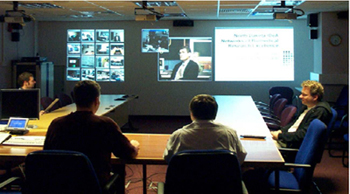e- Science
The UK's e-Science initiative is of primary strategic importance. It is aimed at developing new methodologies for research, and also providing a cohesive framework to support existing, advanced methods, as grid technologies are changing the way that researchers use, study and exchange arts and humanities data.
The principal initiative to encourage the wider adoption of e-Science approaches to research in the arts and humanities is the Arts and Humanities e-Science Support Centre (AHESSC). This is funded by the Arts and Humanities Research Council (AHRC) and the Joint Information Systems Committee (JISC) and is jointly managed by the AHRC ICT Methods Network and the Arts and Humanities Data Service (AHDS).
In order to assist and support AHESSC in the dissemination of information about e-Science to the arts and humanities research community, some general information and definitions of terminology are available on the Methods Network website. Some case study information is duplicated and other references to projects will also be featured on both this site and the AHESSC pages. This reflects the overlap between the two initiatives and also the close working relationship that exists between the projects.
E-Science is essentially a mode of working that is reliant on a distributed number of computing resources, usually residing in physically separate locations, which can all be made to work together for the purposes of one research outcome. An e-Science project will rely on the availability of a grid infrastructure being present to act as the linking component between collaborating organizations; the term ‘grid computing’ is often used as a synonym for a process involving an e-Science methodology. The deployment of grid computing is meant to ensure that researchers benefit from some or all of the following deviations from normal internet working:
- A secure but alternative user-authentication model that allows individuals to access multiple and remote resources.
- Access to significant amounts of computational processing and/or storage capacity.
- The availability of dedicated and highly available bandwidth to facilitate the transfer of larger than normal volumes of data traffic.
- A greater interactivity between participants across a virtual organization by means of video-conferencing, multi-casting and real time collaborative use of tools and digital resources.
- A standardized open-source technology platform.
Put simply, working in a collaborative way over the Internet involves sharing information. The added value of grid-based methods is that researchers can share not only information but equipment as well as very efficient network links. Grid-based computing might be divided into separate categories, each of which will have different degrees of significance for Arts and Humanities researchers.
- Data Grid – the large scale management and sharing of data.
- Computational Grid – the sharing of server processing power to analyse data.
- Service Grid - offers services to users, specific functions that might be required to process scientific experiments
In addition to these categories, there is also
- Access Grid – enabling advanced collaborative virtual meetings
Briefing papers that cover all of these areas of activity are available on the AHESSC pages.
Data Grid
Very large repositories of resources, such as digital libraries and archives, are beginning to be commonplace as funding for digitization projects has disseminated throughout various communities. The Data Grid is the logical method for making large amounts of data accessible to geographically distributed researchers.
Computational Grid
|
|
Photograph with kind permission of the LESC, Imperial College London.
The application of shared computational processing power is most commonly associated with scientific research, but is now being investigated for plausible use across the Arts and Humanities. As datasets grow and techniques develop, it will become increasingly realistic to anticipate the use of computational grid techniques to analyse data originating from Arts and Humanities research – particularly those projects involved with still and moving images.
The Access Grid
|
|
Photograph given with kind permission of AGSC, University of Manchester
The Access Grid provides advanced collaborative and conferencing opportunities for projects requiring or benefiting from distance participation. This might involve the visualization of a performance or simply a more sophisticated way of communicating during project meetings. It has universal relevance for all researchers looking for alternatives to expensive and time-consuming project or conference-related travelling, as well as for performance.


